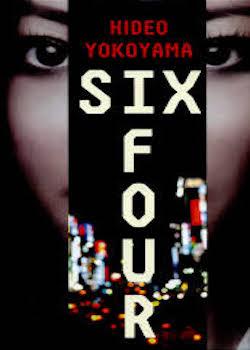Six Four

By Yokoyama Hideo
Translated by Jonathan Lloyd-Davies
Quercus
2016, 640 pages
ISBN 978-1848665255
Review by Charlotte Goff
That the film adaptation of Yokoyama Hideo’s Six Four is to be released in two parts gives us some idea of its size – ‘bulletproof’ is one way that I’ve heard the eighty-one-chapter thriller described. Not trusting cinema-goers’ ability to recall the enormous cast and intricate plot, parts one and two will be screened in Japanese cinemas just a month apart. Six Four requires commitment. While fiction two-timers and commitment-phobes will likely end up confused and disappointed trying to recall just who was Arakida, and what exactly was his relation to Akama, or Akikawa, the dedicated reader will be rewarded with a plot that is gripping, fast-moving and with a twist which, true to the blurb’s promise, ‘no reader could predict’.
January 1989 saw Japan move from the Shōwa to the Heisei era, as Crown Prince Akihito succeeded his father as Emperor. It is in the closing days of Shōwa that the novel’s first victim, seven-year-old Amamiya Shoko, was kidnapped and killed. The ascension of a new Emperor should have been a cause for celebrations across Japan but it instead underlined the failure of the police force in ‘Prefecture D’ to find the murderer; national newspapers which rejoiced the new Emperor poured criticism on the bungled investigation in equal measure. Police officers gave the case the code name ‘Six Four’ – a promise that the killer, despite ‘disappearing into Heisei’, would be dragged back to account for crimes committed in the sixty-fourth and final year of Shōwa.
Fourteen years have passed since the kidnapping, and Mikami Yoshinobu is surprised to hear the case’s secret code name spoken again. Once a detective on the original Six Four team, Mikami has since found himself reassigned as Press Director of the police’s Media Relations wing. He spends much time wrangling with his conscience: do his true loyalties lie in the criminal investigations department where he trained, or the administrative department in which he now finds himself? He struggles, too, with the sudden disappearance of his own teenage daughter and the silent phone calls that follow.
Mikami’s conflicting loyalties lead him to act part-detective, sniffing around for clues to the mysterious Six Four ‘Koda memo’ and shadowing his colleague and former kendo club rival Futawatari, while striving to maintain relations with the local reporters. Fighting the police’s tight-lipped attitude towards information, an increasingly agitated Press Club begin to question police accountability: if all the case information you give us is anonymous, how can we be sure that ‘Person A’ even exists?
Almost as absorbing as the plot itself is the window that Yokoyama (who worked as an investigative journalist for 12 years before beginning as a crime writer) opens onto the workings of the Japanese police force. It is overwhelmingly men that populate both the police departments of Yokoyama’s fiction and their real-life counterparts; Six Four was published in Japanese in 2013, just one year after the National Police Agency’s 2012 White Paper on Crime pledged to raise the proportion of women in the force from 6.8% to 10% by 2023. We see Mikumo, the one female member of Mikami’s staff, struggle to make a meaningful contribution to the department. Much of this world of work takes place outside the office, in bars and karaoke booths, and Mikumo is at one point ‘commanded’ to stay at home. Following Mikumo’s travails, (‘She’s just here to lighten the mood a little’, says one colleague) was one of the book’s frustrations and, later, pleasures.
The first of crime writer Yokoyama Hideo’s works to be translated into English, Six Four is his sixth novel and the second to secure top spot in Japan’s ‘Kono Mystery ga Sugoi!’ annual ranking of the country’s best crime fiction. In just six days after its release, over a million Japanese people bought the Japanese original. Not knowing this before reading it, I came to the novel with just two thoughts about it. The first, ‘It’s huge’ remains true. The second, ‘This will take a while’ was, happily, wrong. It is a testament to Yokoyama’s storytelling that (accounts of Shoko’s kidnapping aside) a book which uses over 600 pages to recount seven days’ events at no point felt slow. The plot and its flawed (and therefore all-the-more-likeable) protagonist gave the book an addictive quality. I could have read more. In the meantime, Japanese speakers can look forward to the film. The less said about the cheesy NHK dramatization the better.

